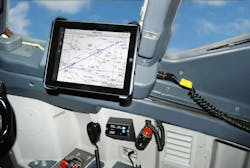Much development has taken place in recent years with the electronic flight bag or EFB. EFB started as an electronic information system device in the cockpit to essentially replace the need for hardcopy manuals, checklists, and charts providing a more efficient means of providing information to flight crews. Paper manuals such as aircraft operating manuals and navigation and ground movement charts are now available on a tablet device in the cockpit. Benefits claimed have been real-time revisions to manuals and charts, weight savings, and reduced pilot workload. It’s all about connecting the user.
EFB does have its place with aircraft maintenance offering many of the same features and efficiencies to maintainers. To learn more about EFB interface with aircraft maintenance I sat down with UTC Aerospace Systems (UTAS).
“We’re all about connecting the user to their environment,” says William Baumgarten. “And that user can also be maintenance personnel using modern mobile technology.” Baumgarten is the business development manager for Cockpit Data Management Solutions with UTC Aerospace Systems. He says, “The UTAS EFB is centered around the aircraft not specifically any one person or user of the information.” The primary market for the UTAS system is the commercial air transport segment but UTAS is also targeting business jets, military transports, and rotorcraft as users of the EFB.
The UTAS EFB began with a high-end system tied into the aircraft’s central maintenance computer. As time went on they started seeing a trend toward mobile technology with users first using laptop computers through a docking station in the cockpit. Baumgarten says, “What we found about three years ago was the move to tablet and mobile devices and came up with a way to connect a tablet to the aircraft.”
The UTAS system has two primary components: the AID and the TIM™. The aircraft interface device (AID) is a cockpit data management (CDM) technology designed with enhanced functionality, broader capabilities, and open architecture. The AID bridges the gap between a hand-held device and the aircraft. The AID also began as part of the FAA’s NextGen navigation program.
The Tablet Interface Module (TIM) works with the AID to allow the user’s tablet to access and display an array of aircraft information. The TIM has mass data storage capability which allows the manuals, documents, charts, checklists, and logbooks to be stored on it. Basically, the TIM is the ship's library.
The AIM and TIM are hardware devices installed on an aircraft under an FAA Supplemental Type Certificate (STC). The STC includes the AID, TIM, cable and connectors, circuit breakers, basically all the hardware is provided to the customer with engineering instructions for installation.
ARINC information goes into the AID from the aircraft and the TIM connects to the tablet device. The tablet typically has three TIM connections; one through a typical cable connection and two connections using Bluetooth wireless technology access. Baumgarten says, “Maintainers have the ability to connect through Bluetooth and move around the aircraft, access manuals, troubleshoot discrepancies, view aircraft history, and sign off a discrepancy.”
The UTAS solution hosts and enables electronic logbook applications that also tie into communications systems through ACARS. A cockpit or cabin crew discrepancy write-up in flight can be sent from the tablet through ACARS to the down line station so maintainers can prepare for defect rectification when the aircraft arrives.
More air carriers and new generation aircraft are moving toward a digital logbook, including discrepancy sign-offs. Using employee ID information the system can verify if a certain pilot is actually on a given airplane, verifying he or she actually did the write-up.
Not as of yet implemented, but through the TIM, pilots could take pictures or video of an event or instrumentation images, and the down line mechanic can view the picture or video as evidence on how an aircraft reacted to a specific discrepancy, again assisting in the preparation for troubleshooting and correction when the aircraft arrives.
According to UTAS new aircraft are capable of providing a fire-hose full of data that can be sent into the TIM. An operator could program the system to capture, display, or alert specific information and specific event information such as speed/flap exceedance or hard landings. Baumgarten says, “Once the system is in an aircraft we have the ability to provide lots of data to lots of tablet devices, including the next generation of tablets or hand-held devices. We have a vision and a roadmap of products to get there - simple solutions for pilots, mechanics, and flight attendants.”
United Airlines is the launch customer for the UTAS EFB system with 150 plus Airbus A320 series currently being installed with the UTAS EFB.
To learn more visit http://www.utcaerospacesystemsefb.com/.
About the Author
Ronald Donner
Aviation Consultant | AMT
Ronald (Ron) Donner has spent his entire life devoted to aviation and he holds FAA certificates as an A&P/IA, and a Commercial Pilot with Single and Multi Engine Land, Instrument Airplane and Glider ratings. Ron has worked in a variety of maintenance related roles, both technical and management in general aviation as well as with a major airline. Ron was the recipient of the 2012 National Air Transportation Association (NATA) Aviation Journalism award.
Contact: Ron Donner
Chief Editor | Aircraft Maintenance Technology
+1-612-670-6048
>> To download the AviationPros media kits, visit: Marketing Resource Center
>>Check out our aviation magazines: Ground Support Worldwide | Airport Business | Aircraft Maintenance Technology

